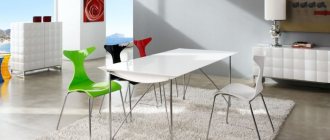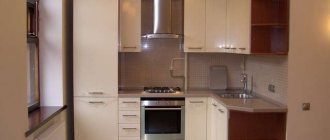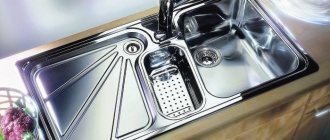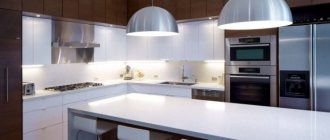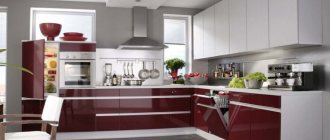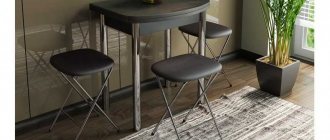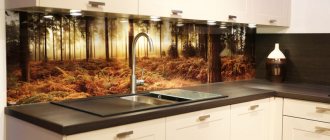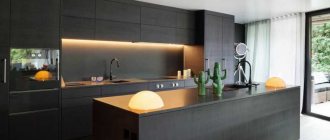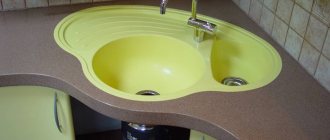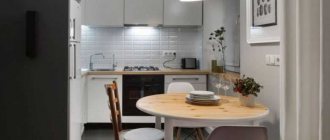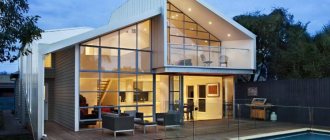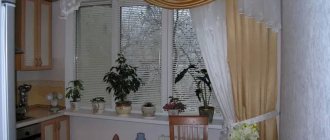Modern German-style kitchens are radically different from their predecessors from the beginning and middle of the last century. The pedantry and love of order and comfort so characteristic of representatives of this nation were also manifested in the peculiarities of arranging kitchen spaces. The interior of German kitchens in general terms is as close as possible to the style of minimalism, with the exception of the set of materials. Therefore, if you need a bright, comfortable and functional kitchen without any decorative excesses, a place where order and cleanliness always reign, where everything is at hand, but in its place, give preference to kitchen design originally from Germany.
Typical style features and characteristics
Of course, it cannot be said that all German-made kitchens are made in the same style and are similar to each other, like close relatives. Moreover, pedantic and practical Germans prefer to make kitchen sets to order, purchasing exclusive designs that are ideally tailored to their homes and apartments in size, functionality and design. Furniture in this country is purchased not for several years, but for decades to come, and is made from durable natural materials. Moreover, many customers choose bright rather than pastel or neutral colors for facades and splashbacks, flooring or accent walls. Each German-style kitchen is unique in its own way, but common features can be seen in most sets and modular combinations:
- laconic design of facades and the entire structure as a whole;
- smooth plain surfaces of calm, natural colors with a predominance of light tones;
- minimum visible fittings;
- closed cabinets where all utensils, equipment, and dishes are stored;
- countertops that combine the set into one whole;
- natural materials;
- spaciousness, conciseness, good natural and artificial lighting;
- practicality and comfort for the housewife who has everything at hand;
- order and cleanliness without any decoration;
- minimum textiles, absence of visible utensils and any items typical of the food preparation area;
- the most modern technology;
- hidden storage systems, dividers in drawers, sliding and folding mechanisms, gas lifts, push-open cabinets, transformable countertops and other advanced developments to improve kitchen functionality;
- strict geometry of furniture.
Features of German cuisine
Seems. that such kitchens are made by robots, not people - everything is so verified, taken into account and provided for. Designers who have been working with such kitchens for many years find in them the reliability of German machines and the tenacity of German football players. And even if this is just a metaphor, such kitchens deserve the most enthusiastic reviews.
The concept of a built-in kitchen was invented in Germany back in the middle of the last century. And since then they have changed little structurally and even externally, acquiring only the features of modern design and decor - however, in a very laconic design.
Calculate the exact cost of repairs using an online calculator
and receive a free detailed estimate for repairs
Calculate
Photo by ReRooms
Most German kitchens these days are made in a modern style. If you want to install a set at home with smooth facades without handles, with a glossy or matte finish, your choice will be limited only by your budget. But in any case, such a set will have common features: smooth facades, rational storage systems, a complete lack of decor, predominantly monochromatic color schemes for decoration, the use of various lighting sources located at different levels.
Photo by ReRooms
Design and layout
The design of German-style apartments can be described in three words: simplicity, practicality and minimalism. As a rule, kitchen modules are united by common countertops and are distinguished by their strict forms and the absence of rounded corners. Typically a kitchen consists of a bottom row of cabinets that look like one unit, with an integrated oven, hob and sink. The upper level is practically indistinguishable from the lower one. Open shelves and transparent doors are almost never used, but island designs are very popular, in which there is space for storing utensils, books, and for washing. Often the island part of the kitchen is combined with a bar counter or a full-fledged table where the whole family gathers, as in the photo below. A separate table also has a rectangular or square shape; it is convenient to slide chairs under it, freeing up space for passage.
Furniture is installed in a linear order, with the letter “P” or “G”; there are also double-row sets, where the cabinets are parallel, along two walls. The main goals that guide the Germans when ordering a new kitchen are comfort, ease of operation and cleaning, and maximum functionality.
Popular brands and product features
There are more and more people wishing to purchase German kitchens in Moscow and other Russian cities, and this is not surprising, given their reliability, ergonomics, durability and aesthetic appeal. The domestic market offers products from many factories, but the most in demand are:
- • Haecker kitchens – products in various styles (mainly with elements of minimalism), pleasing with a combination of sophistication and practicality;
- • Zuchel Küche furniture – will appeal to connoisseurs of exclusive fittings, with silent cabinet opening technology and innovative work surfaces;
- • Siematic kitchens – legendary products that correspond to the latest fashion trends and allow you to transform any interior, while simultaneously providing ample opportunities for culinary experiments;
- • Küchenberg sets – stand out from the rest thanks to their manufacture from high-quality veneer and natural wood with hand-selected patterns;
- • Leicht kitchens – original models in every sense with a long service life and thoughtful design solutions;
- • Nobilia kitchens – presented in classic and ultra-modern styles with the integration of all kinds of engineering innovations and an emphasis on thoughtful decor and build quality.
Functionality and ergonomics
In German kitchens, every item has its own place. And this place is usually located in the depths of numerous drawers, retractable, folding and rotating structures hidden behind smooth facades. All plates and cups, pots and pans, food processors and microwave ovens are removed or built into the set. The cabinets open with a light touch. From the outside, there is nothing to remind you that this is really a kitchen, where food is prepared and eaten every day. Sometimes the purpose of the room is revealed only by the hob and the mixer above the sink.
A German-style kitchen will certainly appeal to housewives who not only love to cook, but also dream of perfect order. Each ladle, knife, cutting board has its own place, and the housewife always knows where to find them. The location of drawers and shelves will be determined by convenience; you can easily and quickly reach any corner of the kitchen to get or put away food, dishes, and equipment. There are no external rails, and if there are, the set of objects hanging on them is minimal.
Practical solutions from Nolte Küchen
This German brand is part of the Nolte Küchen holding, which produces high-quality, but not too expensive, home furniture. Nolte kitchens first appeared on the market in 1958. At first it was a small production, but now the brand’s products are supplied to 60 countries around the world.
The original design and high quality of the products brought Nolte Küchen the silver Architects Partner Award - in 2015 it was awarded in the category “Kitchens”. But that’s not all: in the ranking of kitchen brands compiled by DISQ (German Institute for Service Quality), Nolte took first place in several categories. It turned out to have the widest range of projects, a consistently positive image, the optimal ratio of prices for kitchens and the quality of their assembly, as well as the most favorable warranty conditions.
Colors
The walls, floor, ceiling, furniture fronts and countertops of a German-style kitchen are designed in light or neutral colors. Most often, white and cool colors close to it are used, all shades of natural wood, black, gray, blue, cream, less often lemon, soft mint or turquoise. The walls are painted or covered with plain wallpaper, the fronts of the furniture can be colored, dark or light, contrasting with the countertops. Furniture is often matte rather than glossy.
You won’t find flashy ornaments, textile prints or photo wallpapers in the interior of German cuisine. The decor can be a bright or textured apron, an accent wall (for example, covered with chalk paint), colored floor tiles or decorated with neutral patterns, or wooden beams on the ceiling, as in the example in the photo.
Color solutions for a German-style kitchen
Classic shades for authentic German cuisine - a light neutral palette. But there is no design law that cannot be beautifully violated and create a very impressive space, especially a kitchen one.
Black facades, concrete gray shades, wenge and Milanese walnut colors, pastel colors and even bright saturated colors - there are no prohibitions if the hostess feels comfortable in such a kitchen, and guests are pleased to admire the interior and praise the imagination of the creators of such strict, laconic, comfortable and infinitely beautiful German cuisines.
Accessories
The fittings in German kitchens are usually of the highest quality, the most modern and functional. Closers, gas lifts, built-in, rotating structures, rotating and folding mechanisms are used (additional countertops, retractable cutting boards, drawer dividers. External fittings (handles, holders) are installed infrequently, and if cabinets and tables are equipped with such parts, then they have such the same laconic design as the kitchen itself.
Technique
German-style kitchens are equipped with built-in modern appliances: refrigerators, dishwashers, ovens, hobs, and hoods. All equipment is hidden behind the facades. The only excess that designers allow is the equipment of a functional corner based on the personal wishes of the customer. For example, you love coffee very much and often treat your guests and household members to it. In this case, you can select a special corner where a coffee machine, cabinets and shelves for storing different types of coffee, cups and everything you need for a pleasant coffee drink will be installed.
Lighting
The German style in kitchen design implies an abundance of light and air, which is achieved by maximum natural light and ideal order. Light-colored furniture and the absence of any utensils, equipment, dishes or products in sight visually makes the room more spacious, brighter, and the atmosphere itself lighter. Light, transparent tulle, white linen curtains or Roman blinds that let in the sun's rays are hung on the windows. Several lamps are used in parallel. These can be laconic pendants in the dining area, built-in lamps on a suspended or suspended ceiling, modern laconic lamps with glass or metal lampshades. Often, LED lighting for cabinets becomes a decoration for a German-style kitchen: for the upper level it serves practical purposes, and for the lower level it creates a feeling of weightlessness of the furniture (we are talking about wall-hung models).
Crockery and utensils
The Germans like to cook in dishes made of steel or tempered glass with a laconic design. In use are metal sets of light metal pans, Teflon frying pans with transparent lids, glass saucepans and other utensils. Dishes, on the contrary, must be made of ceramics or porcelain, including baking dishes. German-style sets have minimal decor, most often these are classic white plates, salad bowls, bowls, cups and saucers, transparent glasses and glasses made of glass, steel knives, spoons, forks without patterns, classic or unusual shapes, designs.
